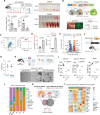This is a preprint.
Temporal Clonal Tracing Reveals Tumor-Intrinsic IFNγ-Dependencies Driving Niche Adaptation and Early Metastatic Colonization
- PMID: 40832237
- PMCID: PMC12363968
- DOI: 10.1101/2025.08.13.669778
Temporal Clonal Tracing Reveals Tumor-Intrinsic IFNγ-Dependencies Driving Niche Adaptation and Early Metastatic Colonization
Abstract
Metastasis is an emergent continuum, driven by evolving reciprocal adaptations between continuously disseminating tumor cells (DTCs) and the specialized metastatic niches of distant organs. The interplay between intrinsic and niche-driven mechanisms that enables DTCs to survive and home to distant organs remains incompletely understood. Here, using MetTag, a single-cell barcoding and transcriptome profiling approach with time-stamped batch identifiers (BC.IDs) and functional CRISPR screening, we resolved the clonality, temporal dynamics, and molecular determinates of DTC colonization success across evolving metastatic niches. Deep sequencing of barcodes revealed preferred enrichment of early-disseminated clones across metastatic niches. Single-cell RNA sequencing (scRNA-seq) coupled with RNA velocity analyses in ascites and metastasis-bearing omenta uncovered an emergent and distinct interferon-gamma (IFNγ) centric transcriptional trajectory, enriched among early seeding clones. In vivo CRISPR/Cas9 screening of metastatic niche-specific signatures demonstrated that genes belonging to the IFNγ response are functionally important for peritoneal metastasis. Knockout of IFNγ receptor 1 (Ifngr1) in the first batch of DTCs significantly reduced metastatic burden and extended survival, underscoring the importance of tumor cell intrinsic IFNγ signaling in shaping post-seeding metastatic niche (PSMN) and subsequent metastatic co-evolution. Mechanistically, tumor intrinsic IFNγ response and ascites-derived tumor-associated macrophages (TAMs) protect cancer cells from anoikis-mediated death by promoting pro-survival signaling. Our study defines temporal dynamics of disseminating tumor cells at metastatic niches and reveals a general "first come, first served" pro-metastatic adaptation principle of DTCs.
Keywords: Anoikis; Clonal dynamics; Disseminating Tumor Cells (DTCs); IFN-gamma (IFNγ); In vivo CRISPR Screen; Lineage tracing; MetTag barcoding; Metastasis; Metastatic niches; Single-cell RNA sequencing.
Conflict of interest statement
DECLARATION OF INTERESTS We do not have any competing interests to declare.
Figures






References
-
- Ritch S.J., and Telleria C.M. (2022). The Transcoelomic Ecosystem and Epithelial Ovarian Cancer Dissemination. Front. Endocrinol. 13, 886533. 10.3389/fendo.2022.886533. - DOI
-
- Motohara T., Masuda K., Morotti M., Zheng Y., El-Sahhar S., Chong K.Y., Wietek N., Alsaadi A., Carrami E.M., Hu Z., et al. (2019). An evolving story of the metastatic voyage of ovarian cancer cells: cellular and molecular orchestration of the adipose-rich metastatic microenvironment. Oncogene 38, 2885–2898. 10.1038/s41388-018-0637-x. - DOI - PMC - PubMed
Publication types
Grants and funding
LinkOut - more resources
Full Text Sources
Research Materials
